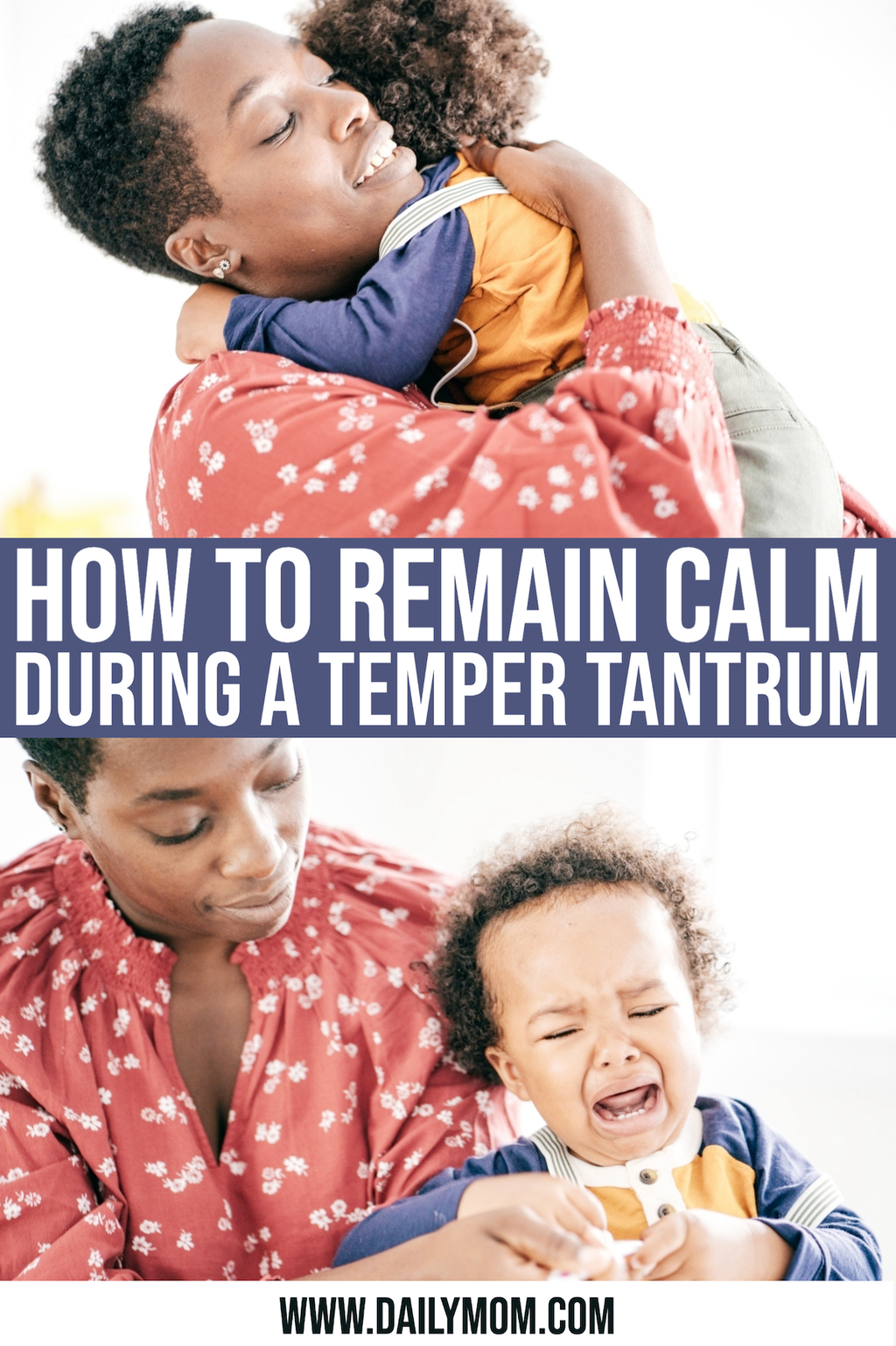Channeling our inner calm can be challenging when our children have been on an all-day marathon of crying, hitting, and screaming. If you’re wondering how to be a calm mom during those temper tantrums, it’s hard. However, there are a few tricks up our sleeve that help us tap into our inner calm mom and we want to share them with you!
Temper Tantrums: 5 Ways To Be a Calm Mom

Yes, it is possible to remain calm, cool, and collected when faced with a toddler tantrum. Check out the 5 most practical ways parents can begin implementing today!
Put yourself in their shoes (understand the tantrum)
It’s easier to react rather than respond to our children’s temper tantrums, however, research shows that when parents validate their children’s feelings, they allow them to explore those feelings and work through them vs. becoming more fearful or anxious about them.
One of the easiest ways to stay grounded and understand their toddler’s temper tantrum is if a parent can put themselves in their child’s shoes. Imagine, you were just reading your favorite book of all time when suddenly your friend walks in and says “let’s go, it’s dinner time”. You shout out, “5 more minutes please”. Then, your friend walks up to you, takes your book, and says, “no more reading, it’s time for dinner”.
Fortunately for adults, we’re able to communicate our needs clearly. A calm adult would respond something like “please give my book back, I asked for 5 more minutes please”. The trick here is, children are still learning how to communicate their needs. And because there’s plenty they don’t fully understand, this is where the tantrum comes in. Once a parent can put themselves in their child’s shoes and think, “how would that make me feel IF I couldn’t communicate my needs”, it might just shift the perspective on tantrums a bit.
Don’t take the temper tantrum personally
Tantrums are nothing to take personally. As a parent, it can be easy to internalize our children’s emotions and outbursts as an attack against us. The truth is, they’re simply an expression of their unmet needs. So, how are you supposed to be a calm mom when your child has unmet needs? The best thing a parent can do for their child to prevent taking it personally is to try and identify what that unmet need is. Take some deep breaths if needed; this is a tough process.
Read More: Eliminate Raising Your Voice in 8 Easy Ways
Identify your own parenting triggers
Yes, parents have their own triggers too. Do you know what your triggers are?
Think about it. If a parent is finding their toddler’s temper tantrums full of screaming and yelling upsetting, it may be because they never learned how to calm themselves down in the midst of chaos in their own childhood. These sounds can be triggering. They can make mom or dad feel completely out of control.
Take some time to really sink into this area and jot down on a piece of paper what type of actions, sounds, or sights can be triggering for you during a tantrum.
Have an outlet for yourself
Both working parents and stay-at-home parents should have some kind of outlet for themselves outside of parenting. These outlets could be a day date with friends, physical activity, arts or crafts, music, self-care time, and more!
Though many parents (especially moms) struggle with the idea of taking a break from parenting, it’s important to take some time away to focus on their own needs as well. When moms say they find themselves feeling “on edge” or “snapping” at their children more during these stressful temper tantrums, it’s likely because they simply need a break.
Model the ways you calm yourself down to them
Once a parent can manage their own triggers and emotions, they’ll be able to model these tactics to their children. Children are very visual learners, meaning they learn best by mimicking what they see. If they see a stressed-out parent 24/7, they will likely pick up these unhealthy coping habits. However, if they see a parent who can cope and calm down from a stressful situation, they’ll learn to do the same during a temper tantrum.
Why do toddlers throw temper tantrums?

Understanding WHY toddlers throw temper tantrums in the first place is a helpful starting point to being able to identify their needs and help them meet those needs within reason.
What are temper tantrums?
A tantrum is commonly described as the act of a child showing frustration or anger as a result of having an unmet need (or needs). As children get older and learn positive coping strategies to move through their feelings (and meet their needs), temper tantrums tend to decrease over that time period.
What does a normal toddler tantrum look like?
Toddler temper tantrums can be pretty, for lack of better words, dramatic. A toddler may be seen:
- Kicking, biting, or hitting
- Crying or screaming
- Throwing themselves to the ground
- Refusing to follow direction from their parent or caregiver
When to be concerned about your toddler’s tantrums
Although toddler temper tantrums are a very normal part of toddlerhood, there are a few signs parents should pay attention to:
- The frequency of the tantrum (if a toddler is having multiple temper tantrums every single day of the week, parents should contact their pediatrician for support).
- Uncontrollable crying (though crying and screaming can be a normal part of a tantrum, uncontrollable crying or screaming with no sign of calming down can be a sign of something more going on).
- The length it takes for the tantrum to end (a typical tantrum shouldn’t last more than 20-30 minutes at a time).
- Worsening behaviors (if any parent feels like their child’s behaviors are becoming harmful, self-destructive, or worst than usual, they should contact their pediatrician for support immediately).
Read More: Why Behavioral Health in Children is Important
How to respond to tantrums

Now that it’s a bit easier to identify why tantrums happen, the next step is to understand how to respond to them without being too frustrated or angry. Being frustrated and angry is a normal feeling to have when you’re faced with temper tantrums. However, try to remember that when your child is already upset, they need to balance out those feelings with a calm adult, not an angry one.
Be empathetic
Even though something as simple as ending an activity because it’s dinner time comes easy for many adults, it doesn’t come that easy for a child. Show children some empathy for what they’re being asked to do and how it is taking away from their enjoyment at the moment. Help them feel noticed by saying something like, “you wish you could keep playing with your toys don’t you? It’s really hard to stop when we’re having fun.”
If parents can show their children they’re on their side rather than controlling their every move, they may be surprised at the positive results over time. This is one of the hardest challenges of parenting, so don’t expect to be perfect with these techniques. Instead, prioritize making subtle changes one day at a time. Before you know it, you’ll see an incredible difference starting to show.
Remember, empathy is a basic human need. Our children need to feel understood and connected, but all within appropriate limits and boundaries.
Try to identify the need
This one can be tricky as sometimes toddler needs may seem a bit irrational (especially in the middle of a temper tantrum), but if parents focus pretty hard, they can usually find the deeper need. These needs could be a child being sleepy, hungry, not feeling well, feeling anxious or scared, etc…
Choose your words wisely
If you’re still struggling to figure out how to be a calm mom in the middle of the madness, this lesson is important. Oftentimes less is more when it comes to children. As parents, we tend to want to explain every little thing when our toddlers throw a tantrum. Then, we want to make sure they know what they did was unacceptable by explaining it again and asking them questions like “do you understand me?” — only to find it retriggers the tantrum.
Instead of busting out into full explanation mode, take a step back. Try to identify what is upsetting your child. Then approach with a simple message: “you really wish you could play longer, let’s see when we can play with these toys again”.
Read More: Emotional Regulation: 6 Simple Ways to Help Your Child
Respond, don’t react
Responding and reacting are two very different approaches. Reacting is when the outcome is completely disregarded for the need for instant satisfaction whereas Responding takes into consideration the outcome and presents itself in a calm state. As parents, especially of a dysregulated child, it’s crucial to focus on responding to our children so they feel heard and validated.
Hold your boundaries
Common misconceptions parents have is that by validating a child’s feelings they aren’t able to hold their boundaries, but that couldn’t be any farther from the truth. Let’s go back to the dinnertime example. You tell your child it’s time to eat and they proceed to throw a tantrum because they want to keep playing with their toys. You respond with “you really wish you could play longer, let’s see when we can play with these toys again, but first it’s dinner time”.
YOU are setting the clear boundary that it is now time to eat dinner. Will you be there to help your child find a new time to play with their toys again? Absolutely. However, right now it’s dinner time and that is non-negotiable.
Parenting toddlers is far from easy and staying calm during the storm is an entirely different challenge on its own. Being perfect is not the goal we’re after here, but showing up and putting effort in each and every day is. Effort towards being a little more empathetic. Effort towards remaining calm. Remember, you can do this, you can channel your inner calm mom by practicing these simple tips above. You’ve got this mama!
WANT TO READ MORE?
Check out this article on Managing Your Anxiety as a Mom.











































